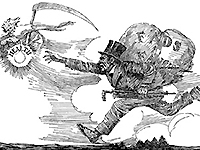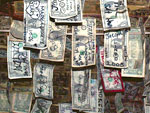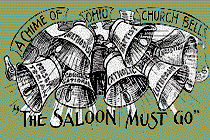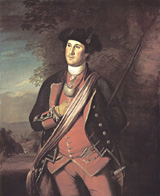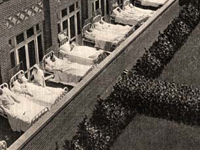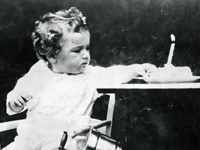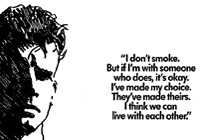Stumbling Down the Road to Health
In every era, people chase the shining ideal of long life and perfect health—but sometimes the tools they use harm more than help. From poisonous pills to deadly drinking water, the next best thing has often been anything but. Choose the correct answers for the questions below:
1. Calomel, made popular by physician and patriot Dr. Benjamin Rush in the late 18th century, was perhaps the most commonly prescribed medicine through the first half of the 19th century. In the 1850s, it was recognized that the most important ingredient, which induced salivation and vomiting, poisoned patients over the long run. What was that ingredient?
b. Mercury. Specifically, Mercurous chloride, which, when acted on by stomach acid, freed the mercury and settled in the joints, loosened the teeth, inflamed the gums, and, with continued or heavy use, could result in mental debility and death.
2. Starting in the 1930s, shoe stores commonly measured children's feet with a new machine. This machine promised to ensure precise fitting of shoes, allowing children's feet room to grow properly. The machines were banned in the 1950s, however, because they used what to measure the feet?
b. X-rays. The shoe stores' young customers were directed to stand up against a cabinet and place their feet, still in their shoes, inside. An x-ray image of their feet inside their shoes could then be viewed on a screen.
3. In the 1920s and 1930s, manufacturers of consumer goods identified a new "rejuvenating" and "reinvigorating" ingredient that they added to face cream, lipstick, sunburn cream, toothpaste, and chocolate. Most of these products were made in Europe and imported into the U.S., but they were all eventually banned as health risks. What ingredient caused concern?
a. Radium. The Radior Company in London manufactured radium-impregnated foundation power and other radioactive cosmetics. French and German manufacturers sold radium toothpaste and chocolate and also used thorium in cosmetics.
4. Beginning in 1870, General Augustus J. Pleasanton (1808-1894) publicly promoted bathing in light of a specific color. Pleasanton and his advocates believed the light was a panacea which would cure most ailments and give people supernormal physical and mental powers. From 1875 to 1877, replacing clear glass windowpanes with glass panes tinted this color became a national craze. What color was it?
c. Blue. The "Blue Glass Cure" was the brainchild of Pleasanton, who wrote The Influence of the Blue Ray of the Sunlight and the Blue Colour of the Sky, in developing animal and vegetable life; in arresting disease, and in restoring health in acute and chronic disorders to human and domestic animals … in 1876.
5. From 1952 to 1956, manufacturer P. Lorillard sold its brand of Kent cigarettes with special "Micronite" filters. The filters were made of cellulose, acetate, and a third ingredient, intended to increase the cigarettes' ability to deliver less harmful smoke. Instead, this ingredient caused its own health concerns, leading Lorillard to discontinue its use. What was the ingredient?
a. Asbestos. Industrial workers mixed an especially pernicious form of asbestos with cellulose and acetate in huge machines to create Crocodilite fibers. Many of these workers later developed cancer.
6. From the 1860s and well into the 20th century, special belts were marketed to men. Designed to be worn around the waist (some with downward extensions), they were supposed to rejuvenate men who felt "weak" in some way. Magnets were sewn into the first belts, but by the 1880s, many belts used something else that aimed to "rejuvenate the flesh." What was it?
d. Electrical current. The first belts, with copper or silver discs sewn in, produced their weak current through soaking in salt water. Later belts used batteries to produce their current.
 For more on health in U.S. history (and the business, ethical and not, of medicine), search NHEC’s Website Reviews using Topic: Health and Medicine, to turn up reviews and links to websites including Duke University’s Medicine and Madison Avenue,—a collection of health-related advertisements from the 1910s through the 1950s—and the Eugenics Archive, an online archive and exhibit documenting a sinister health “fad."
For more on health in U.S. history (and the business, ethical and not, of medicine), search NHEC’s Website Reviews using Topic: Health and Medicine, to turn up reviews and links to websites including Duke University’s Medicine and Madison Avenue,—a collection of health-related advertisements from the 1910s through the 1950s—and the Eugenics Archive, an online archive and exhibit documenting a sinister health “fad."
The Hagley Museum and Library hosts a digital exhibit on patent medicines, while the Smithsonian Institution’s National Museum of American History offers the digital Balm of America: Patent Medicine Collection
If you want to bring some drama into your classroom, Donald W. Gregory’s play Radium Girls tells the story of a group of early 20th-century New Jersey factory girls who painted watch faces with “harmless" radium—and found themselves developing jaw cancer from “tipping" their paintbrushes on their tongues. The play also looks at the use of radium in other products, including health drinks, and the exposes and cover-ups that occurred when people began to learn about radium’s effects. Claudia Clark’s book Radium Girls: Women and Industrial Health Reform: 1910-1935 takes a scholarly, nonfictionalized look at the same story.
The Internet Archive provides the full text of Augustus Pleasonton’s The Influence of the Blue Ray of Sunlight ….
- Ads for Dr. A. Reed Shoe Company X-Ray Shoe Fitter machines. Los
Angeles Times, (Los Angeles, CA) 1929. - Ads for Radior cosmetic products. New York Times, (New York,
NY) 1916-1919. - "Blue Glass Bonanza." Denver Daily News, (Denver, CO) Jun. 11, 1876.
- "Blue Glass," sheet music, by Sam Devere, published by Louis Goullaud,
Boston, 1877. - "Drs. Owen, Cheever, Heidelberg, Horne, Edison, Copeland, Sanden,
Cook, Bennett, and Chrystal electric belts," 1875-1889, newspaper ad
for Health and Strength Regained, 1896. - Gibbons, Roy. "Ban on X-Ray Shoe Fitting Devices Urged," Chicago
Daily Tribune, (Chicago, IL) June 3, 1959. - Mack, E. "Blue Glass Schottische." Philadelphia: F. A North, 1877.
- Oak Ridge Associated Universities. "Shoe-Fitting
Flouroscope" Health Physics
Historical Instrumentation Museum Collection. 26 January
2010. http://www.orau.org/ptp/collection/shoefittingfluor/shoe.htm. - Pancoast, Seth.
Blue
and Red Light; or, Light and its rays as medicine; showing that light
is the original and sole source of life …. Philadelphia: J.
M. Stoddart, 1877. - Pleasanton, Augustus James. The
Influence of the Blue Ray of the Sunlight. Philadelphia:
Claxton, Remsen and Haffelfinger, 1876. - "States Urged: Outlaw X-Ray in Shoe Fitting," Chicago Daily
Tribune, (Chicago, IL) August 26, 1958. - "Supernal Vision; the Culminating Scientific Discovery of the Century;
Wonders of Blue Light: Females Seven Years of Age Developed into
Full-Grown Women: Thought Becoming Apparent," St. Louis
Globe-Democrat, (St. Louis, MO) July 16, 1876. - Youmans, E.L. "Editor's Table: Concerning 'Blue Glass,'" Popular
Science Monthly, May-Oct. 1877.
